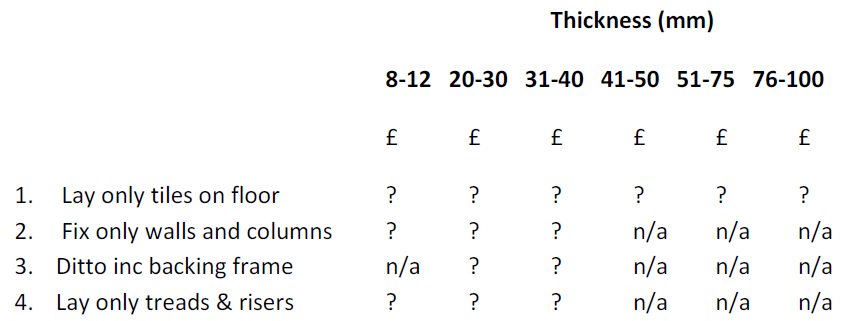Schedule of rates for construction
Contents |
[edit] Introduction
In its most simple form, a schedule of rates can be a list in a contract setting out the staff, labour and plant hire rates the contractor will use for pricing cost reimbursable instructed daywork.
However, on a much larger scale, a 'schedule of rates term contract', 'term contract' or 'measured term contract' may be used when the nature of work required is known but it cannot be quantified, or if continuity of programme cannot be determined. In the absence of an estimate, tenderers quote unit rates against a document that is intended to cover all likely activities that might form part of the works.
As the extent of the work is unknown, the unit rates include overheads and profit. General preliminaries such as scaffolding, temporary power, supervision and temporary accommodation will also have rates. On projects longer than around 18 months there might be escalation provisions based on annual percentage increases.
[edit] Pros and cons
The advantages of schedule of rates term contracts include:
- Variations are easier to estimate and normally cheaper than on fixed price traditional contracts.
- The client can stop and start work at a pace that might be determined by cash flow or funding.
- A larger pool of contractors can be asked to tender as the process is inexpensive and quick.
- It is flexible in relation to scope and contractual commitment.
- As a fully-detailed design is not required the client can obtain tenders at the early stages of a project and begin construction before completion of the design. So to this extent it is 'fast track'.
The disadvantages include:
- Additional resources are required to measure work and certify payments.
- The client does not have a final price when committing to starting work.
- It is difficult for contractors to plan long-term resources and so might mean changes to personnel with loss of continuity.
- Contractors may be tempted to front-load costs in case later work does not materialise.
- There is no real incentive for contractors to treat such work with any sense of urgency and its best staff will be placed on the projects where the contractor is carrying more risk.
The tender documents will be a substantial package looking like a bill of quantities with numerous options and discount opportunities based on quantity.
[edit] Tender documents
Tender documents might have the following headings:
[edit] General conditions
- Methods of measurement.
- Qualification of star and proportional rates.
- Site preliminaries.
- Treatment of overtime rates.
- Codes of practice.
- Inclusion of protection, waste, transportation and health and safety compliance.
- Approved list of suppliers.
- What is included in rates,such as all subsistence and travel expenses.
- Client direct supplies and directly employed tradesmen.
- Testing and commissioning.
- Curved work premium.
- Definitions as used in the document.
[edit] Building work
- Demolition.
- Geotechnical investigation.
- Excavation.
- Concrete work.
- Brick and blockwork and masonry.
- Roofing and tanking.
- Scaffolding and staging.
- Carpentry and joinery.
- Ironmongery.
- Steel and metalwork.
- Fire shutters.
- Plasterwork, floor, wall, ceiling finishes.
- Plumbing and drainage including cable ducts.
- Fixtures, fittings and soft furnishings.
- Demountable partitions, dry walling and cubicles.
- External works.
- Labour.
- Plant and equipment hire.
[edit] Mechanical and electrical, lifts and escalators
- Electrical installation.
- High voltage switchgear.
- Transformers.
- Low voltage switchgear.
- Standby generators.
- Air conditioning and ventilation.
- Building Management System (BMS) controls.
- Fire services.
- Town gas.
- Catering equipment.
- Intruder alarm.
- Public address system.
- External lighting and electric gates.
- Lifts.
- Escalators.
- Cleaning cradle system.
Each of these headings will cover numerous elements which then have to be broken down into pricing units. For instance brick, blockwork and masonry might include a section called natural marble or granite slabs/tiles of any shape, size pattern or colour :
[edit] Benchmark rates
A number of indices are available providing benchmark rates that can be used for estimating purposes, such as the BCIS Schedule of Rates, the PSA Schedule of Rates, and so on.
[edit] Related articles on Designing Buildings
- Admeasurement.
- Bill of quantities.
- Charge-out rate.
- Construction contract.
- Construction person year.
- Difference between lump sum and measurement contracts.
- Henry Boot Construction Ltd v Alstom Combined Cycles.
- Measurement contract.
- Preliminaries.
- Procurement route.
- Rates.
- Remeasurement.
- Schedule.
- Tender documents.
- Term contract.
- Unit rates basis of payment.
Featured articles and news
The UK's Modern Industrial Strategy: A 10 year plan
Previous consultation criticism, current key elements and general support with some persisting reservations.
Building Safety Regulator reforms
New roles, new staff and a new fast track service pave the way for a single construction regulator.
Architectural Technologist CPDs and Communications
CIAT CPD… and how you can do it!
Cooling centres and cool spaces
Managing extreme heat in cities by directing the public to places for heat stress relief and water sources.
Winter gardens: A brief history and warm variations
Extending the season with glass in different forms and terms.
Restoring Great Yarmouth's Winter Gardens
Transforming one of the least sustainable constructions imaginable.
Construction Skills Mission Board launch sector drive
Newly formed government and industry collaboration set strategy for recruiting an additional 100,000 construction workers a year.
New Architects Code comes into effect in September 2025
ARB Architects Code of Conduct and Practice available with ongoing consultation regarding guidance.
Welsh Skills Body (Medr) launches ambitious plan
The new skills body brings together funding and regulation of tertiary education and research for the devolved nation.
Paul Gandy FCIOB announced as next CIOB President
Former Tilbury Douglas CEO takes helm.
UK Infrastructure: A 10 Year Strategy. In brief with reactions
With the National Infrastructure and Service Transformation Authority (NISTA).
Ebenezer Howard: inventor of the garden city. Book review.
The Grenfell Tower fire, eight years on
A time to pause and reflect as Dubai tower block fire reported just before anniversary.
Airtightness Topic Guide BSRIA TG 27/2025
Explaining the basics of airtightness, what it is, why it's important, when it's required and how it's carried out.
Construction contract awards hit lowest point of 2025
Plummeting for second consecutive month, intensifying concerns for housing and infrastructure goals.
Understanding Mental Health in the Built Environment 2025
Examining the state of mental health in construction, shedding light on levels of stress, anxiety and depression.























Comments
Here is an example of a schedule of rates for UK building, construction and maintenance works:
(http://www.constructionrates.co.uk/Schedule_of_Rates/Construction_National_Schedule_Rates_Measurement_NRSM_Dynamic.html)
and another example of a Schedule Of Rates (SOR) for Singapore Housing and Development Board (HDB) building tradesmen & repair works:
(https://hdb-sor.netlify.app)